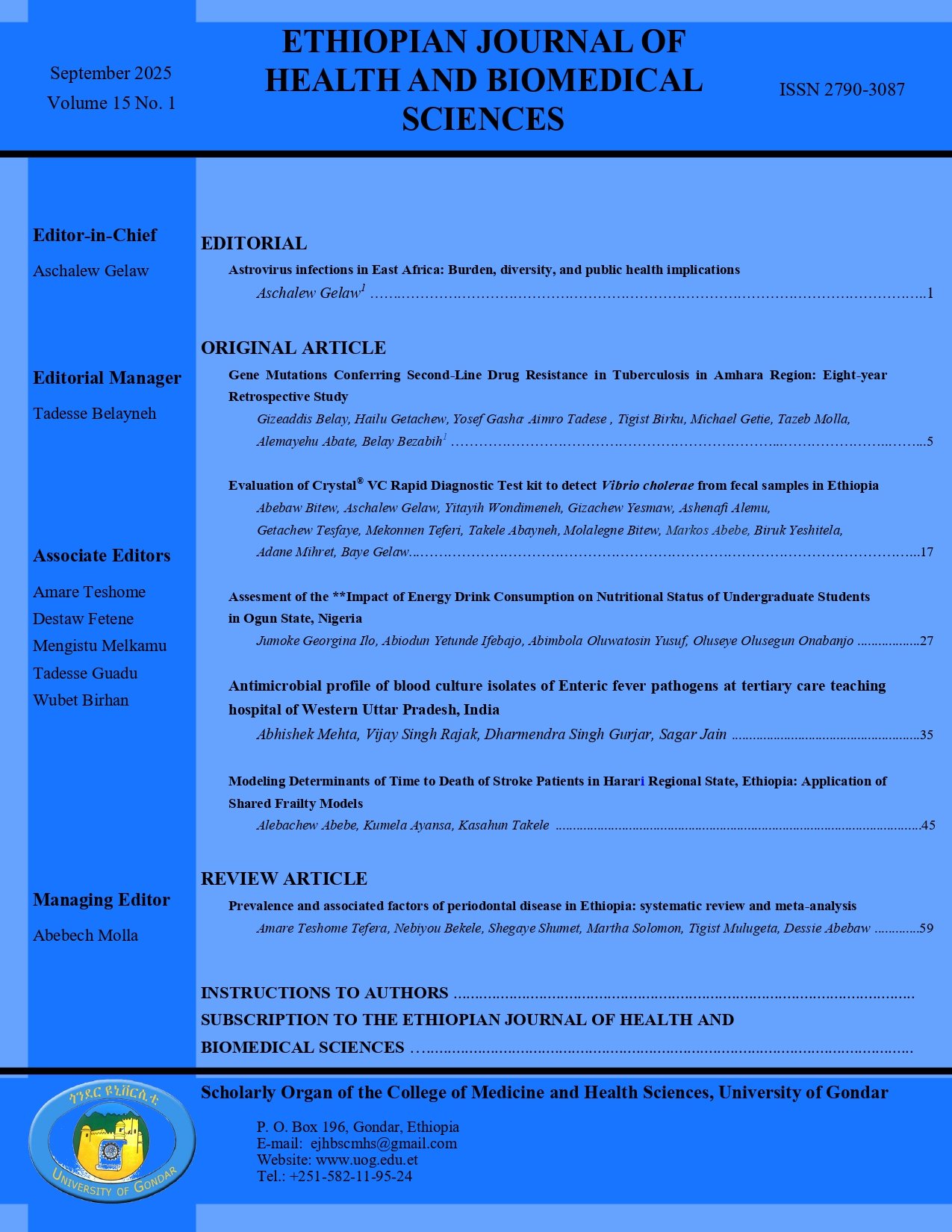Review on the epidemiology of astrovirus infections in East Africa and its public health significance
DOI:
https://doi.org/10.20372/ejhbs.v15i1.1126Keywords:
Astovirus, East Africa, genetic diversity, prevalenceAbstract
Gastroenteritis remains a major global health concern, causing an estimated 2.3 billion illnesses and 1.3 million deaths annually (1). Enteric viruses are responsi-ble for nearly 70% of these cases, with more than 20 distinct viral agents identi-fied to date (2). Among the most common viral causes of diarrhea are members of the Reoviridae, Adenoviridae, Caliciviridae, and Astroviridae families (3). Since their initial discovery in 1975, astrovirus (AstVs) has been recognized as important etiologic agents of viral gastroenteritis , particularly among infants and young children worldwide, with the burden disproportionately higher in low-and middle-income countries (4, 5).
Astroviruses are non-enveloped, icosahedral viruses measuring approximately28–30 nm in diameter, and are distinguished by their characteristic star-like ap-pearance. They belong to the Astroviridae family and have a single-stranded, positive-sense RNA genome of about 6.8 kb in length, which is organized into three open reading frames (ORFs). The ORF1a and ORF1b encode non-structural proteins, while ORF2 encodes capsid proteins (4). The Astroviridae family includes two genera: Mamastrovirus and Avastrovirus. Human infections are primarily associated with Mamastrovirus species, particularly MAstV-1, MAstV-6, MAstV-8, and MAstV-9. The classic HAstVs (HAstV-1 to HAstV-8) belong to MAstV-1, while recently identified novel strains include HAstV-MLB (MAstV-6), HAstV-VA2/4 and HMO-A (MAstV-8), and HAstV-VA1/3, HMO-B/C, and PS (MAstV-9)(6). While several studies from East African countries have reported the presence of HAstVs among under-five children, most have lacked in-depth genetic characterization. Nevertheless, both classic and novel astrovirus types have been detected in the region. Six of the eight classic HAstV types, excluding HAstV-6 and HAstV-7, have been reported in the region. In Ethiopia, HAstV positivity ranged from 3.6% to 5.3%, with genotypes HAstV-1, 2, 3, and 8 detected (7, 8). In Kenya, positivity rates varied between 2.8% and 9.7% across multiple studies, with both classic and non-classic genotypes such as MLB and VA strains identified (9, 10-12). Malawi (1.9%), Sudan (3%), Madagascar (2.1%), and Tanzania (0.4%) also reported HAstV cases (113-16), with Malawi and Madagascar identifying multiple genotypes including HAstV-1 to 5 and HAstV-8 (15, 16). Detection methods varied slightly (RT-PCR, ELISA, EIA).
Astroviruses are primarily associated with gastroenteritis; how-ever, growing evidence also indicates their capacity to cause extra-intestinal infections, including meningitis and encephali-tis (5, 17). These severe manifestations are often linked to nov-el astrovirus strains. In Tanzania, MLB1 and MLB2 strains were detected among febrile children, while the AV1 was iden-tified in a nasopharyngeal sample from another febrile child (18, 19). Although HAstVs predominantly affect children (4), they have also been detected in the elderly, immunocompro-mised individuals, and even healthy adults (20). In immuno-compromised patients, infections tend to be more severe and may involve the central nervous system (20, 5). In tropical climate settings, astrovirus infection often follow seasonal pat-terns, with increased incidence during the rainy season, possi-bly due to increased viral stability in cool, moist environments and greater indoor crowding. Outbreaks have been documented in high-density communal environments such as schools, day-care centers, military facilities, and swimming pools (6). Transmission of HAstVs is mainly fecal-oral, as confirmed by volunteer studies (21), although the role of other transmission routs warrants further investigation.
Despite the recognized global burden of astrovirus-related gas-troenteritis, particularly in young children, research in East Africa remains limited in both population level coverage and depth. Most available studies are confined to under-five chil-dren, with little attention to infections in adults, elderly, or im-munocompromised populations. Comprehensive genomic based evidence is lacking, with limited data on genotype diver-sity, recombination potential, and the emergence of novel strains. Additionally, extra-intestinal manifestations, potential environmental reservoirs, zoonotic transmission, and seasonal patterns are underexplored in the regional context. To address these knowledge gaps, expanded active surveillance and mo-lecular studies are urgently needed. Further research should include diverse age groups, clinical presentation, and compre-hensive one health approach studies to understand of the trans-mission dynamics and detail virological properties. F Further-more, integration of astrovirus monitoring into public health
surveillance programs, alongside investment in vaccine and antiviral development, will be crucial for reducing the disease burden and preventing future outbreaks.
Downloads
Published
How to Cite
Issue
Section
License
Copyright (c) 2025 Aschalew Gelaw

This work is licensed under a Creative Commons Attribution-NonCommercial 4.0 International License.


